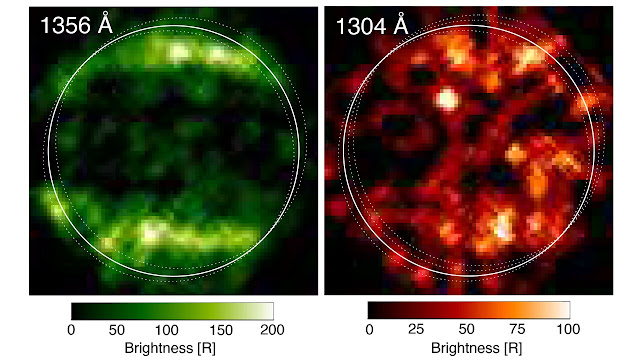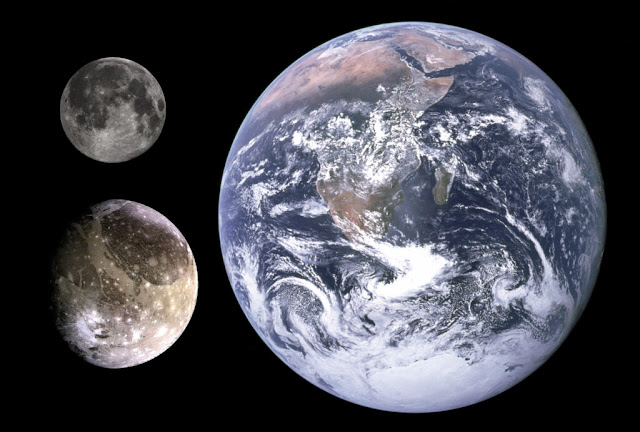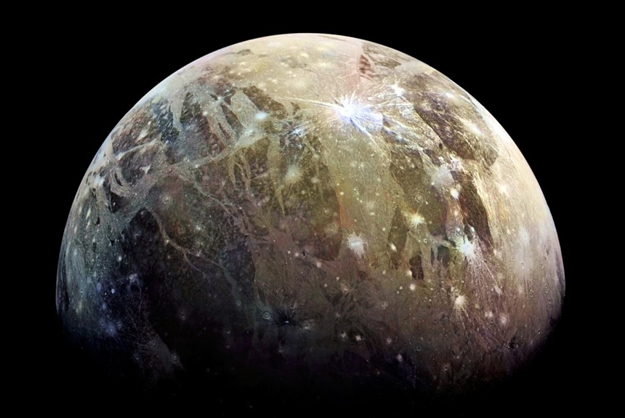Hubble discovers water on Jupiter’s moon Ganymede, marking a first-time finding.
In a groundbreaking discovery, scientists have found conclusive evidence of water vapor in the atmosphere of Ganymede, which is the largest moon in the solar system and orbits Jupiter. It is believed that the frozen water on the moon’s surface may have sublimated, meaning it transitioned from solid to gas state without passing through a liquid state.
Ganymede is characterized by a unique terrain consisting of dark, cratered regions and bright, grooved patterns that have long fascinated researchers. Although it was previously hypothesized that the moon has a significant amount of water, more than that of Earth, the distance of Ganymede from the sun makes it difficult for liquid water to exist without being covered by a thick layer of ice.
The moon is thought to have three primary layers, including a metallic iron core, a rocky mantle, and a layer of frozen and liquid water. The ice shell on the outer layer is known to be exceptionally thick, about 500 miles (800 kilometers), which could potentially cover any liquid water underneath it. Nonetheless, the presence of water, whether liquid or vapor, could indicate the possibility of life.
This marks the first time that scientists have detected non-ice water on Ganymede’s surface. Using Hubble’s Cosmic Origins Spectrograph in 2018 and archival images from the Space Telescope Imaging Spectrograph from 1998 to 2010, Lorenz Roth of the KTH Royal Institute of Technology in Stockholm, Sweden, and his team were able to measure the amount of oxygen on the moon. This was part of a broader observation program.
The ultraviolet (UV) images of Ganymede were first captured by Hubble’s Space Telescope Imaging Spectrograph (STIS) in 1998, revealing an interesting pattern in the emissions observed from the moon’s atmosphere. These emissions showed auroral bands that resemble the aurora ovals observed on Earth and other planets that have magnetic fields, providing concrete evidence that Ganymede has a permanent magnetic field. The presence of molecular oxygen (O2) explains the similarities in the ultraviolet observations, while the differences were attributed to the existence of atomic oxygen (O), which produces a signal that affects one UV color more than the other. The credit for this discovery goes to NASA, ESA, and Lorenz Roth of KTH.

In 1998, the first ultraviolet (UV) images of Ganymede were taken by Hubble’s Space Telescope Imaging Spectrograph (STIS), which showed auroral bands on the moon’s atmosphere similar to those observed on other planets with magnetic fields. This discovery revealed that Ganymede has a permanent magnetic field, and it was assumed that the UV observations were due to the presence of atomic oxygen (O). However, recent research by Lorenz Roth’s team at the KTH Royal Institute of Technology in Stockholm, Sweden found little evidence of atomic oxygen in Ganymede’s atmosphere.
Upon closer examination of the UV images, the researchers found that the distribution of the colorful ribbons of electrified gas called auroral bands varied with Ganymede’s surface temperature, which changes throughout the day. It was observed that the equatorial regions of Ganymede release small amounts of water molecules when the surface becomes sufficiently warm, which fits excellently with the Hubble data. The presumed oxygen in 1998 was likely water vapor originating from ice sublimation caused by the thermal escape of water vapor from warm icy regions.
This finding makes Ganymede an even more intriguing place, especially for the European Space Agency’s upcoming mission, JUICE (JUpiter ICy moons Explorer), scheduled to launch in 2022 and arrive at Jupiter in 2029. The mission will spend three years making detailed observations of Jupiter and its largest moons, including Ganymede. Roth believes that the team’s findings can provide valuable information for the JUICE instrument teams to refine their observation plans and optimize the use of the spacecraft.

Scientists are now considering icy moons around Jupiter and Saturn as potential places where life could develop, a stark contrast to their previous status as lifeless, frozen environments. As more research is conducted on these moons, their habitability appears to be more plausible. However, it’s important to note that the mere possibility of life on Ganymede does not guarantee its existence, and further studies are necessary to explore this potential.
Do not forget to share your opinion with us to provide you with the best posts !




0 Comments